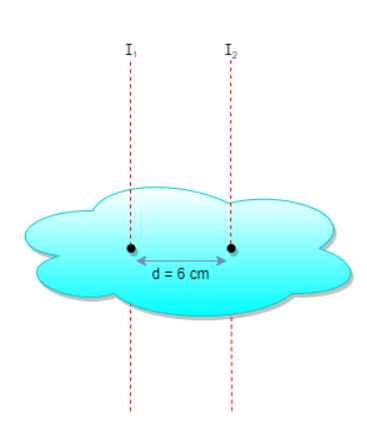
The radius of gyration of a body about an axis at a distance 6cm from its center of mass is 10 cm. Then, its radius of gyration about a parallel axis through its center of mass will be:
A. 80 cm
B. 8 cm
C. 0.8 cm
D. 80 m
Answer
585k+ views
Hint: Before attempting this question one should have prior knowledge about the gyration of body and also remember to use parallel axis theorem i.e. ${I_{parallel}} = {I_{cm}} + M{d^2}$here \[{I_{parallel}}\] is the momentum of inertia of body and ${I_{cm}}$ is the momentum about the center and d is the distance between the 2 parallel axes, use this information to approach towards the solution.

According to the given information we have body which have radius of gyration about an axis which is 6cm from its center of mass is 10cm
Before approaching the solution of the question let’s discuss what radius of gyration is?
Radius of gyration can be defined as the imaginary point where it is assumed to exist a concentrated mass of the body from the center of the body and the momentum of inertia at the radius of gyration is assumed to be the same as about the axis of actual mass. The momentum of inertia of a body in terms of radius of gyration is represented as $I = M{k^2}$
Since it is given that the distance of radius of gyration from center of mass is 6 cm
So by the parallel axis theorem we can say that ${I_{parallel}} = {I_{cm}} + M{d^2}$here \[{I_{parallel}}\] is the momentum of inertia of body and ${I_{cm}}$ is the momentum about the center and d is the distance between the 2 parallel axes
Substituting the given values in the above equation
${I_1} = {I_2} + M{d^2}$
Substituting the given values in the above value
$M{\left( 6 \right)^2} = {I_2} + M{\left( {10} \right)^2}$
$ \Rightarrow $${I_2} = M{\left( {10} \right)^2} - M{\left( 6 \right)^2}$
$ \Rightarrow $\[{I_2} = M\left[ {{{\left( {10} \right)}^2} - {{\left( 6 \right)}^2}} \right]\]
$ \Rightarrow $${I_2} = M\left( {100 - 36} \right)$
$ \Rightarrow $${I_2} = M\left( {64} \right)$
$ \Rightarrow $${I_2} = M{\left( 8 \right)^2}$
Comparing the general equation of $I = M{k^2}$ by above equation we get
k = 8 cm
So radius of gyration of axis through the center of mass will be 8 cm
Hence option B is the correct option.
Note: The center of mass that we used in the above solution can be explained as the fixed location relative to an entity or group of objects. This is the average position of all elements of the system, weighted by their masses. The center of mass is found in the centroid, for simple solid structures of uniform density.

According to the given information we have body which have radius of gyration about an axis which is 6cm from its center of mass is 10cm
Before approaching the solution of the question let’s discuss what radius of gyration is?
Radius of gyration can be defined as the imaginary point where it is assumed to exist a concentrated mass of the body from the center of the body and the momentum of inertia at the radius of gyration is assumed to be the same as about the axis of actual mass. The momentum of inertia of a body in terms of radius of gyration is represented as $I = M{k^2}$
Since it is given that the distance of radius of gyration from center of mass is 6 cm
So by the parallel axis theorem we can say that ${I_{parallel}} = {I_{cm}} + M{d^2}$here \[{I_{parallel}}\] is the momentum of inertia of body and ${I_{cm}}$ is the momentum about the center and d is the distance between the 2 parallel axes
Substituting the given values in the above equation
${I_1} = {I_2} + M{d^2}$
Substituting the given values in the above value
$M{\left( 6 \right)^2} = {I_2} + M{\left( {10} \right)^2}$
$ \Rightarrow $${I_2} = M{\left( {10} \right)^2} - M{\left( 6 \right)^2}$
$ \Rightarrow $\[{I_2} = M\left[ {{{\left( {10} \right)}^2} - {{\left( 6 \right)}^2}} \right]\]
$ \Rightarrow $${I_2} = M\left( {100 - 36} \right)$
$ \Rightarrow $${I_2} = M\left( {64} \right)$
$ \Rightarrow $${I_2} = M{\left( 8 \right)^2}$
Comparing the general equation of $I = M{k^2}$ by above equation we get
k = 8 cm
So radius of gyration of axis through the center of mass will be 8 cm
Hence option B is the correct option.
Note: The center of mass that we used in the above solution can be explained as the fixed location relative to an entity or group of objects. This is the average position of all elements of the system, weighted by their masses. The center of mass is found in the centroid, for simple solid structures of uniform density.
Recently Updated Pages
Master Class 11 Economics: Engaging Questions & Answers for Success

Master Class 11 English: Engaging Questions & Answers for Success

Master Class 11 Social Science: Engaging Questions & Answers for Success

Master Class 11 Biology: Engaging Questions & Answers for Success

Class 11 Question and Answer - Your Ultimate Solutions Guide

Master Class 11 Business Studies: Engaging Questions & Answers for Success

Trending doubts
What is meant by exothermic and endothermic reactions class 11 chemistry CBSE

1 Quintal is equal to a 110 kg b 10 kg c 100kg d 1000 class 11 physics CBSE

What is periodicity class 11 chemistry CBSE

Explain zero factorial class 11 maths CBSE

What is a periderm How does periderm formation take class 11 biology CBSE

What are porins class 11 biology CBSE




